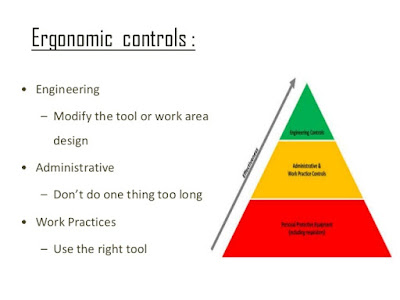WORK PHYSIOLOGY AND AEROBIC CAPACITY
Work physiology is a term associated with industrial
engineering that is concerned how the human body copes with physical
stress, work strain, and the working environment.
Work physiologists apply their understanding in
evaluating and designing work spaces that reduce physical fatigue, eliminate
occupational injuries, and increase overall productivity. They need to
understand how the body performs under a variety of environmental conditions,
the amount of rest it requires, and when it is able to work at peak levels.
Capacity for physical work
An individual’s physical tolerance to
physical work is usually determined by the capacity of his or her cardiovascular
and respiratory system sto deliver oxygen to the working muscles and to
metabolize chemically stored energy.
Metabolism, respiration, and circulation
are just a few of the body systems that physiologists study. They also take
into account skeletal, muscular, and cardiovascular activity. Work
physiologists are concerned with the metabolic cost of work and attempt to
minimize it by making the work space as ergonomic as
possible.
A work physiology laboratory has all the
equipment necessary to measure parameters like heart rate, oxygen consumption, and core temperature. This
branch of physiology also studies the changes that result in the human body as
a result of being exposed to single or multiple instances of work stress.Knowledge
obtained from work physiology is used to design work spaces that suit a wide
variety of people.
The goal of work physiology is to ensure that the worker
performs his or her task safely in the most efficient manner possible within
the work environment. Human beings come in all sizes and shapes, and this
makes it challenging for work physiologists to design environments suited to
every type. Normally, the environment isn't a controlled one — there may be
loud noises, flying dust particles, and heat, for example, which the body has
to deal with. This branch of physiology monitors the amount of energy people
spend on their task and ensures that they aren't pushed beyond their physical
capacity to work.
Matching people and their
work
Obviously, it is important to match
human capabilities with the related requirement of a given job. If the job
demands equal the worker’s capabilities or if they exceed them, the person will
be under much strain and may be not able to perform task. Hence, various
functional stress tests, which are administered by a physician, have been developed
to assess an individual’s capability to perform physically demanding work.
Work capacity or fitness level of an individual can be
determined in laboratory by measuring the VO2 max. VO2
max is indicative of aerobic fitness level.
Aerobic work capacity is the highest amount of oxygen consumed during
maximal exercise in activities that use the large muscle groups in the legs or
arms and legs combined. Aerobic capacity, aerobic power, functional capacity,
functional aerobic capacity, maximal functional capacity, cardiorespiratory
fitness, cardiovascular fitness, maximal oxygen intake, and maximal oxygen
uptake are terms that are often used interchangeably.
Aerobic capacity is commonly described by the o2max, or maximal oxygen uptake. This measurement is an
indication of (1) the ability of the cardiovascular system to provide
oxygen to working muscles and (2) the ability of those muscles to extract oxygen for
energy generation in the form of adenosine triphosphate (ATP).
VO2max is a measure of the maximum amount of oxygen that an individual can use
per unit of time during strenuous physical exertion at sea level. It is an
important measure for several reasons:
(1) It serves as an index of
cardiovascular and pulmonary function;
(2) It characterizes the functional
capacity of the cardiopulmonary system to transport oxygen to the
working muscles; and
(3) It is one of the limiting factors
in endurance performance.
Men who are 20 years of age have an
average maximal capacity of 3-3.5L/min; women of the same age have an average
capacity of 2.3-2.8 l/min. At age of 60 the capacity is diminished to about
2.2-2.5 L/min. for men and 1.8-2.0 L/min for women.
An individual’s VO2max can be measured or estimated by a variety of
techniques, including treadmill running, cycle ergometry, arm
cranking, and stair stepping, rowing, and walking.
The most common way to measure VO2max is by open-circuit spirometry,
whereby the individual breathes in ambient air and then the exhaled air is
measured and analyzed. The amount of oxygen consumed (VO2) can be computed on the basis of the composition
of the inspired air by quantifying the volume (V) and oxygen (O2) content of the expired air.
Work/rest cycles: Fatigue is an overexertion phenomenon that leads to a temporary decrease in physical performance. In order to avoid the fatigue and especially the chronic fatigue, rest pauses must be taken. Frequent short rest periods reduce cumulative fatigue better than a few long breaks.












